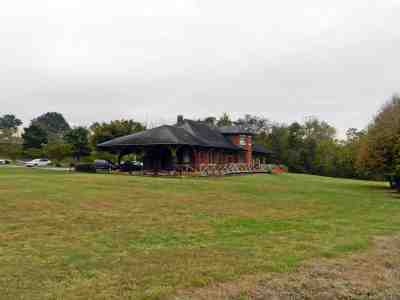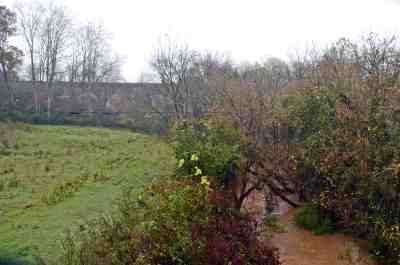The Ghost Train
One August night 2010 a group of young people had gone out to the railroad tracks to observe a ghost train that was supposed to arrive at night and crash from a bridge across a gorge right outside town. One 29 year old man and his girlfriend walked out on the bridge to get a better look while the rest of the group stopped before the bridge Around 3 am they did hear a train approaching. Unfortunately for the young man, it was not a ghost train and it didn't pass through him as ghosts are supposed to do. In stead it was a passenger train from the Norfolk Southern Railroad, that had been delayed, and were driving faster that usual trying to catch up on lost time. The engineer got sight of the group near the beginning of the bridge and blew his whistle while at the same time trying to stop the train. Everybody managed to get away except for the two pepole on the bridge who tried to run to safety while staying as far from the rails as possible but to no avail. The young man was hit by the train and was killed instantly while the young woman was thrown from the bridge, landed on the slope and got away with a sprained ankle and other minor bruises.
But let's go back in time, to discover why the group of ghost hunters thought a ghost train would be present.
Back in time

The old railway depot that was used in 1891 is long gone. Another depot building (in the photo) replaced it in 1906. This buiding today serves as headquarter of the Statesville Police Traffic Patrol.
On the early morning of August 27th 1891, a passenger train from the Western North Carolina Railroad left the railway depot in Statesville, county seat of Iredell County, North Carolina. The train had begun it's journey in Richmond, Virginia and was heading for Asheville in southwestern North Carolina. It had made a stop in Danville on the Virginia-North Carolina border, where 12 years later another train would be derailed. In Statesville new passengers had boarded the train and some freight had been taken on board as well. Also the train had been resupplied with fuel (coal) and water for the engine. Sometime around 2.30 am, the train known as Number 9 (from Engine no. 9) left the Statesville Depot. The stop had taken longer than planned, and the train was about 30 minutes late, when it left the depot. The plan was to catch up with this delay before Asheville. Five minutes after leaving the depot, the train reached The Bostian Bridge 2.5 miles from the depot, running at a speed of around 40 miles per hour. A few seconds later, the train was derailed. The engine landed on the slope, while the tender, the baggage car, a second class car, a first class coach, a sleeper car and a private but empty saloon car belonging to the superintendant of the railway company crashed 60 feet into the gorge. Through the gorge ran a small stream, Third Creek, and the second class car landed in the stream. Later surveys showed that the sleeper car landed 153 feet from where it was derailed and the same was true for the private car. Some cars landed on top of each other, the first class coach on top of the second class car and the private car on top of the sleeper car. Some of the passengers in the cars that landed on the bottom were crushed from the weight of the cars landing on top. Some of the rails broke loose from the ties and fell into the gorge where they speared the cars below and also some of the passengers were hit by falling rails. In the days before the accident the area had been exposed to heavy rainfall, and there was much more water in the creek than usual. The car in the creek blocked the flow of the water which quickly rose, and some of the passengers, who were trapped in the second class car, drowned. A woman, Miss Poole, who survived the accident, later told that she had tried to keep her unconcious mother's head above water. but she became so tired, that she had to let go and her mother drowned. The engineer was found crushed under the engine cabin. Next to him were two women, who had been passengers in the first class coach. How they ended up there was never settled, They may have been visiting the enigineer until the next stop, but it is also possible that they either were thrown from or jumped from the train before their coach fell all the way into the gorge.
Some of the survivors were in such good shape, that they were able to walk along the tracks back to the depot where they alerted the railway employees of the accident. The whole town was alerted and many volunteered for the rescue operation. They of course had to find and rescue survivors, but were also given the task of locating the bodies of those who had been killed. The wounded were taken back to Statesville and as the town had no hospital at the time, the wounded passengers were accommodated in private homes, where they taken care of as good as possible. The few doctors in town helped whereever and as much as they could. The bodies of the dead were placed in a tobacco warehouse, where familiy members later were asked to try to identify their relatives. 20 people died immediately while 3 to 6 later died of their wounds (the different sources don't agree on the number). Up to 26 people lost their lives and more than 30 were badly wounded in the disaster, that is still the worst in the history of Iredell County and one of the worst in the state of north Carolina.
The next day prisoners from the prison in Newton 25 miles away, were sent out to help, but even so it took several days before a full overview of the extent of the disaster and it's cause was obtained. Some of the survivors told at the inquest held after the accident, that seconds before the train left the track, they had had a feeling like the train had been bumping on the rails. The coroner in charge of the inquest concluded after also hearing testimonies from engineers from the railway company, that the accident had happened because one or more unknown persons had removed some of the spikes that held the rails to the ties. A lot of people were arrested and questioned but everyone proved innocent and was set free. Not until 6 years later, in 1897, the culprits were caught and that was by pure coincidence. Two men, who was incarcerated for another and unrelated crime, confessed to other inmates, that they were the ones that had stolen the spikes. This confession was enough and the two men were convicted of the crime.
Many people gathered both at the railway depot and at the site of the accident. Among the latter were a photographer who took some of the few pictures from the site, that we know of today. After what we know, he took five photos of which four is kept in the Iredell County Library. What happened to the last photo is not known to me, but the library holds a scanned version of it. It's possible that more photos were taken, but a lot of the works of the photographer were lost in a fire many years ago.
The day after the accident a list of the killed passengers and crew (20 at that time) could be read in a Charlotte newspaper. Among the killed was baggage master Hugh. K. Linster who had worked for the railway company for more that 30 years and earlier in the day of the accident, before the train left Richmond, he had been awarded a gold pocket watch for his faithful service. When the train left Statesville he had asked one of the surviving passengers what time it was, as he was afraid that his new watch was not showing the correct time. It was though, but as mentioned above the train was running late which was the reason for his confusion.
Forward in time
Why was the ghost hunters near the bridge in 2010? Hunting for ghosts of course!

Third Creek and in the background the Bostian Bridge in 2015.
On August 27th 1941 on the 50th anniversary of the disaster a woman was stranded with a flat tyre near the bridge. From a nearby house she had called for her husband to come and help her. While waiting she saw a train coming like out of nowhere. She heard the sound of the train turning into loud noises and screams and she saw the train tumble from the bridge. When she went to look down to the gorge she saw the wreck and heard screams and moans from the wounded. She returned to her car, and when her husband arrived with a man from town to help changing the tyre, she told them what she had seen, and the three of them went to help, but when they got to the site of the accident there was nothing to see.
Many years later another woman experienced an almost identical situation. She had stopped her car around 100 yards before the bridge, next to the site of a landscaping company, I don't know why she stopped there in the middle of the night, but she was out of her car when she heard loud noises of something crushing. She ran about 100 yard along the road to get a free look and saw the wreck in the gorge and she too heard screams from wounded people. She and her husband had only recently moved to the area, and she didn't know the old story. She ran back to a house a couple of hundred yards away and asked for help. When she and a couple of people, who were not to pleased to be woken up at three in the morning, arrived at the scene, they found nothing there.
Other people has reported similar incidents, and some even claim to have met an elderly man dressed in a old fashioned railway uniform, who asked them what time it was. When they looked up from their watches the man had disappered. Is it Mr. Linster who still doesn't trust his new watch?
The Bostian Bridge is still there and is passed by trains every day though only freight trains as no passenger trains have run from Statesville to Asheville in more than 40 years.